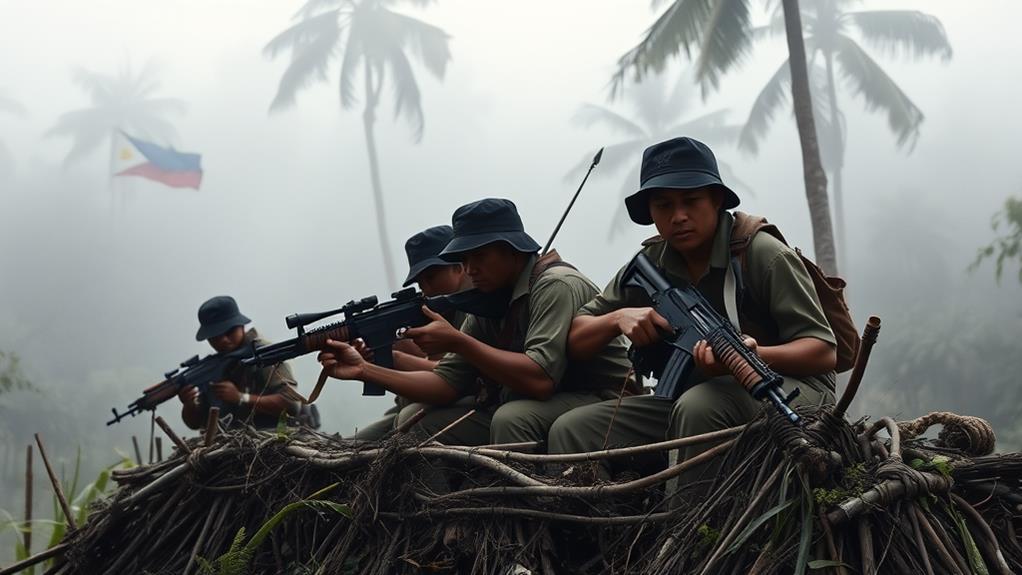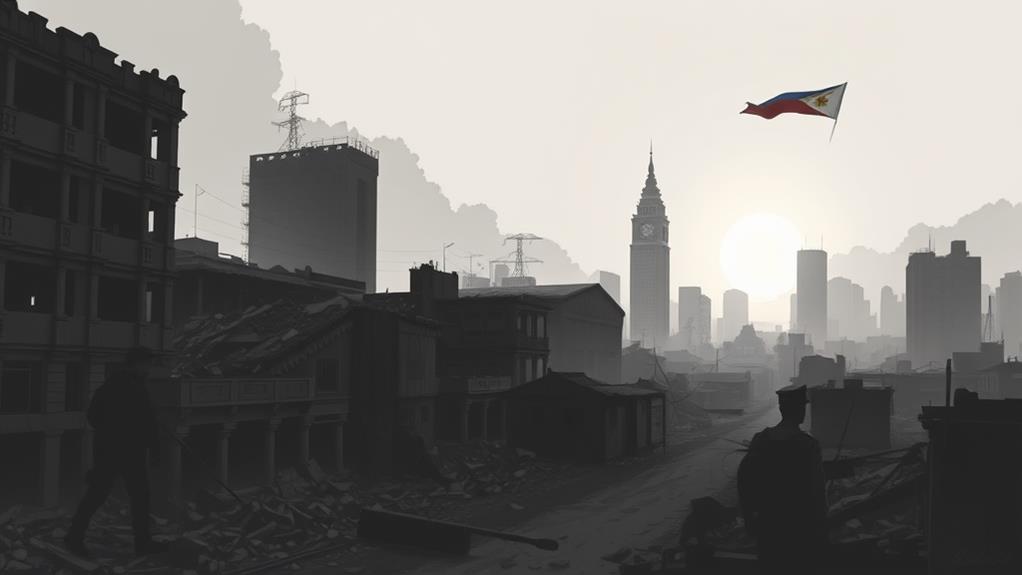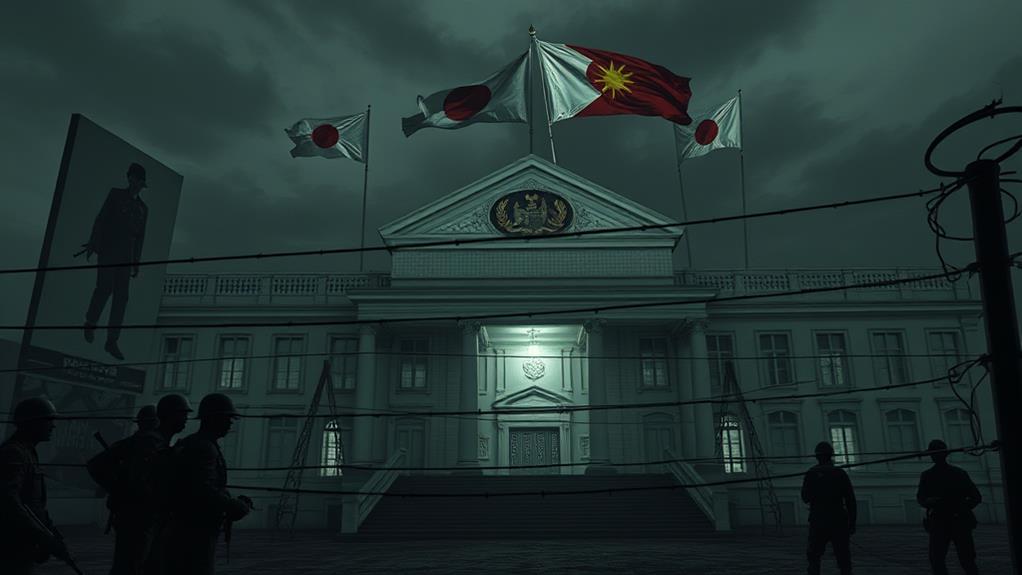The Japanese Occupation: A Dark Chapter in Philippine History
The Japanese occupation of the Philippines from 1942 to 1945 was a brutal period marked by atrocities, human suffering, and a relentless struggle for freedom. An estimated 500,000 lives were lost during this time, and widespread destruction occurred throughout the country.
One of the most notorious atrocities committed during this period was the Bataan Death March, where thousands of Filipino and American prisoners of war were forced to march through the jungle with minimal food, water, and medical care, resulting in the deaths of thousands.
Additionally, thousands of women and children were forced into sexual slavery by the Japanese military.
Despite the brutal conditions, Filipino guerrilla fighters continued to resist the Japanese occupation, employing tactics such as sabotage, ambushes, and intelligence gathering to disrupt Japanese operations.
The Japanese occupation also led to the establishment of collaborator governments and puppet administrations, which further complicated the dynamics of resistance and loyalty.
Understanding the complexities of this period is crucial to grasping the lasting impact of the Japanese occupation on Philippine society.
Historical Context of the War
The Philippine Islands: A Strategic Location in Southeast Asia
The Philippine Islands, a crucial location in Southeast Asia, became a target of Japan's expansionist policies in the early 1940s.
This led to one of the darkest chapters in Philippine history.
The Fall of the Philippines and the United States
As World War II raged on, Japan's military might proved too great for the combined forces of the Philippines and the United States, led by General Douglas MacArthur.
The swift invasion resulted in the surrender of troops in Bataan on April 10, 1942, and the fall of Corregidor on May 6, 1942, marking the beginning of the Japanese occupation.
Resistance Against the Japanese Regime
During this period, guerrilla activities emerged as a form of resistance against the Japanese regime.
Despite the odds, around 260,000 Filipinos participated in various resistance movements, fighting for their country's freedom.
Human Rights Violations and Casualties
The Japanese occupation was also marred by human rights violations, including the infamous Bataan Death March, which added to the estimated 500,000 Filipino casualties during the war.
Understanding the Historical Context
Understanding the historical context of the war is crucial in grasping the significance of this period in Philippine history.
Japanese Brutality and Atrocities
The Japanese occupation of the Philippines was marked by unimaginable brutality and atrocities. During this period, Filipinos faced harsh realities, including the estimated murder of 131,028 Filipino civilians and seventy-two large-scale massacres.
The Japanese committed heinous war crimes, including the forced sexual slavery of over a thousand Filipinos, mostly women and children, as "comfort women" in comfort stations. These victims were subjected to torture, gang-rape, and murder, including infants.
The covert biological warfare research unit, Unit 731, conducted brutal experiments on Filipinos, including vivisection and other inhumane medical practices.
One of the most brutal events in Philippine history is the Bataan Death March, where over 75,000 American and Filipino prisoners were forced to march, resulting in an estimated 5,000 to 18,000 deaths due to disease, malnutrition, and execution.
These atrocities serve as a grim reminder of the horrors inflicted upon the Filipino people during the Japanese occupation.
Filipino Resistance and Guerrilla Warfare

The Filipino people showed remarkable resilience and determination to resist their occupiers despite the brutality of the Japanese occupation.
Approximately 260,000 Filipinos joined various guerrilla organizations across the islands, demonstrating widespread resistance against the Japanese military. Leaders like Colonel Macario Peralta in Panay and Colonel Wendell Fertig in Mindanao coordinated efforts that significantly disrupted Japanese operations and communications.
Guerrilla forces controlled about 60% of the Philippine islands, using forested areas for covert operations and sabotage against Japanese troops. General Douglas MacArthur provided resources and reinforcements via submarine to bolster resistance efforts.
Notable acts of sabotage included attacks on Japanese supply lines and communication networks, which played a crucial role in undermining Japanese control throughout the occupation. These acts of sabotage were crucial in disrupting Japanese operations and ultimately contributed to the Filipino people's quest for freedom.
The Philippine resistance was a testament to the Filipino people's unwavering spirit and their unrelenting quest for freedom.
Life Under Japanese Occupation
Life Under Japanese Occupation
Daily life in the Philippines was a struggle during the Japanese occupation, marked by scarcity and brutality.
Filipinos lived in constant fear of human rights violations, as the Japanese military enforced strict military rule, suppressing Filipino culture and promoting their own ideology.
Harsh Realities
The occupation was characterized by:
- Widespread human rights violations, including murder and sexual slavery.
- Erasure of local customs and practices under Japanese military rule.
- Severe economic hardship, with shortages of food and essential goods.
- Suppression of Filipino culture, promoting Japanese ideology instead.
- Constant fear of brutality, fostering a spirit of resilience and resistance.
Resisting the Occupation
Despite the brutal conditions, Filipinos found ways to resist.
Approximately 260,000 individuals joined guerrilla resistance movements, opposing Japanese forces and coordinating sabotage efforts against their operations.
This spirit of resistance amidst widespread suffering and brutality is a testament to the Filipino people's strength and determination.
Liberation and Aftermath of the War

The Philippines' Liberation Began in 1944
The Philippines' long-awaited liberation from Japanese occupation started on October 20, 1944, when General MacArthur returned to the country. This marked the beginning of a massive campaign against Japanese forces, involving approximately 700 vessels and 174,000 troops.
By December 1944, the Allies had recaptured key locations such as Leyte and Mindoro.
The Devastating Battle of Manila
However, the Battle of Manila in early 1945 resulted in extensive destruction and significant civilian casualties, with an estimated 100,000 Filipino civilians killed during the conflict.
The Human Cost of the War
The war had a profound human cost, with approximately 500,000 Filipinos dying during the Japanese occupation.
Additionally, 10,380 U.S. military personnel died, and 36,550 were wounded.
Post-War Discussions and Legacy
As the war came to an end, post-war discussions focused on war crimes and reparations, particularly regarding the treatment of comfort women and the legacy of the atrocities committed during the occupation.
This dark chapter in Philippine history serves as a poignant reminder of the devastating consequences of war.
The Bataan Death March Tragedy
The Bataan Death March: A Tragic Episode in Philippine History
The Defeat in Bataan
The Allied forces' defeat in Bataan in April 1942 marked a dark turning point in the war, leading to one of the most notorious atrocities in Philippine history: the Bataan Death March.
The March Begins
The march began on April 9, 1942, following the surrender of Bataan, and was characterized by extreme physical abuse and inhumane treatment by the Japanese military.
The prisoners were forced to march 66 miles under brutal conditions.
Casualties and Hardships
An estimated 5,000 to 18,000 men died along the route due to disease, malnutrition, and execution during the march.
Survivors faced further hardships in prisoner-of-war camps, where conditions remained dire and many continued to suffer from starvation and disease.
Symbol of Resilience and Resistance
The Bataan Death March has become a symbol of Filipino and American resilience and resistance during World War II.
The march is remembered annually in the Philippines and recognized in historical narratives about wartime atrocities.
Lasting Impact
The Bataan Death March has had a lasting impact on Philippine history, serving as a reminder of the hardship and suffering endured by the prisoners of war.
Collaborators and Puppet Governments

During Japan's occupation of the Philippines, a complex web of collaboration and resistance emerged. Some Filipinos chose to collaborate with the Japanese military in exchange for power and influence. The Japanese established a puppet government in 1943, with Josué P. Laurel as its president, to promote Japanese propaganda and suppress anti-Japanese sentiments.
| Collaborators | Puppet Government |
|---|---|
| Provincial elites and local leaders who supported Japanese rule | Established by the Japanese military in 1943 |
| Gained power and influence | Aimed to promote Japanese propaganda |
| Faced opposition from Filipino guerrilla groups | |
| Faced public disdain post-war | Led by Josué P. Laurel as president |
The legacy of collaboration during the occupation remains a contentious topic in Philippine history. Accusations of collaboration against leaders like Laurel led to widespread public disdain post-war. Although Laurel was never formally tried due to a general amnesty in 1948, the debate about the motivations and actions of those who aligned with the Japanese authorities continues to this day.
Comfort Women and Sexual Slavery
The Japanese occupation of the Philippines during World War II was marked by a horrific chapter of human rights violations, where thousands of women and girls were forcibly taken and enslaved as "comfort women."
During this period, over 1,000 Filipino women and girls were abducted and subjected to sexual slavery in military-run brothels known as comfort stations. This wasn't an isolated incident, as an estimated 400,000 women and girls across Asia were victimized by Japanese forces during World War II.
The experiences of Filipino comfort women were marked by extreme physical and psychological abuse, including systematic rape, torture, and violence, often in front of other victims.
These atrocities led to ongoing struggles for recognition, reparations, and justice, which continue to this day.
The issue of comfort women remains a significant aspect of discussions on war crimes and human rights violations, highlighting the need for historical acknowledgment and memorialization of these atrocities.
The Japanese forces' actions constitute a grave violation of human rights, and it's essential to recognize the survivors' experiences and struggles for justice.
How did the Japanese Occupation impact the Philippines, including Palawan?
During the Japanese Occupation, the Philippines, including Palawan, suffered from harsh conditions and atrocities. Despite the challenging times, Palawan’s hidden gems, such as its pristine beaches and stunning landscapes, remained untouched and preserved. Today, these hidden gems continue to attract tourists and serve as a reminder of the resilience of the Filipino people.
Lasting Impact on Philippine Society

The Japanese occupation had a lasting impact on Philippine society, affecting its demographics, economy, and social fabric.
The occupation resulted in the deaths of approximately 500,000 Filipinos, significantly impacting the population and contributing to a post-war demographic decline. This decline was evident in the reduced population growth rate and changes in population structure.
The economic disruptions were severe, leading to widespread poverty and inflation. Essential goods became scarce, and a black market emerged to cope with shortages. For instance, rice, a staple food in the Philippines, became a luxury item.
The human rights violations, including the systematic sexual enslavement of over 1,000 Filipino women as comfort women, left deep scars on societal morals and gender relations in post-war Philippines. This traumatic experience contributed to long-term psychological trauma and stigma for the victims and their families.
However, the brutality of the occupation fostered a strong sense of nationalism and resilience among Filipinos, ultimately influencing post-war political movements and the quest for true independence. This sense of nationalism is evident in the formation of guerrilla groups that fought against the Japanese occupation.
Today, the legacy of the occupation continues to shape Philippine historical consciousness, with educational initiatives aimed at preserving the memory of atrocities and promoting awareness of human rights.
These initiatives include history lessons that highlight the experiences of Filipinos during the war and memorials that honor the victims of the occupation.
Questions and Answers
How Did the Japanese Occupation Affect the Philippines?
The Japanese occupation had a devastating impact on the Philippines.
The economy suffered greatly, with inflation and food shortages becoming rampant. This was due to the disruption of trade and commerce, as well as the exploitation of the country's resources by the Japanese.
The human cost was significant, with an estimated 131,028 civilians murdered during the occupation. Additionally, thousands of women were forced into sexual slavery, known as "comfort women." The total number of deaths, including those from war, famine, and disease, reached over 500,000.
Despite the brutality, the Filipino people showed remarkable resilience. Many Filipinos joined guerrilla organizations, with an estimated 260,000 involved in the fight against the Japanese occupation. These groups played a crucial role in disrupting Japanese supply lines and communication networks.
The dark legacy of the Japanese occupation continues to shape the nation's identity and historical consciousness. The experience has left a lasting impact on the country, influencing its relationships with other nations and informing its national policies.
What Was the Japanese Occupation in the Philippines Abuse?
The Japanese occupation in the Philippines was marked by extreme brutality and abuse.
This abuse took many forms, including murder, torture, and sexual slavery.
An estimated 131,028 Filipino civilians were killed during the occupation.
Additionally, 1,000 women and girls were forced into "comfort women" roles, a euphemism for sexual slavery.
Prisoners were treated brutally, subjected to inhumane medical experiments and extreme brutality, including gang-rape and the murder of infants.
These atrocities reflect a culture of violence that defined the occupation.
What Was the Most Destroyed Area in the Philippines During the Japanese Occupation?
Manila was the most destroyed area in the Philippines during the Japanese occupation.
This city suffered extensive damage, with an estimated 100,000 civilians killed and approximately 90% of its structures destroyed or heavily damaged.
The destruction was so severe that Manila was referred to as "the most devastated city in the world" after World War II.
Who Liberated the Philippines From Japanese Occupation?
The Philippines was liberated from Japanese occupation by a joint effort led by General Douglas MacArthur.
This liberation campaign involved the combined forces of the United States and the Philippine Commonwealth Army, along with Filipino guerrilla fighters.
The operation was massive, with approximately 700 vessels and 174,000 troops participating.
Ultimately, this effort led to the country's liberation in 1946.